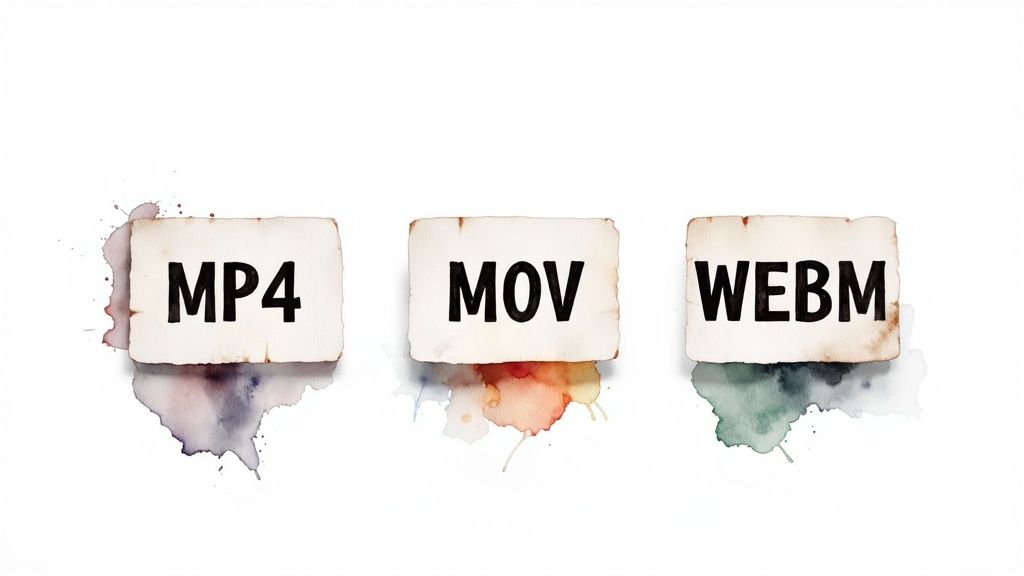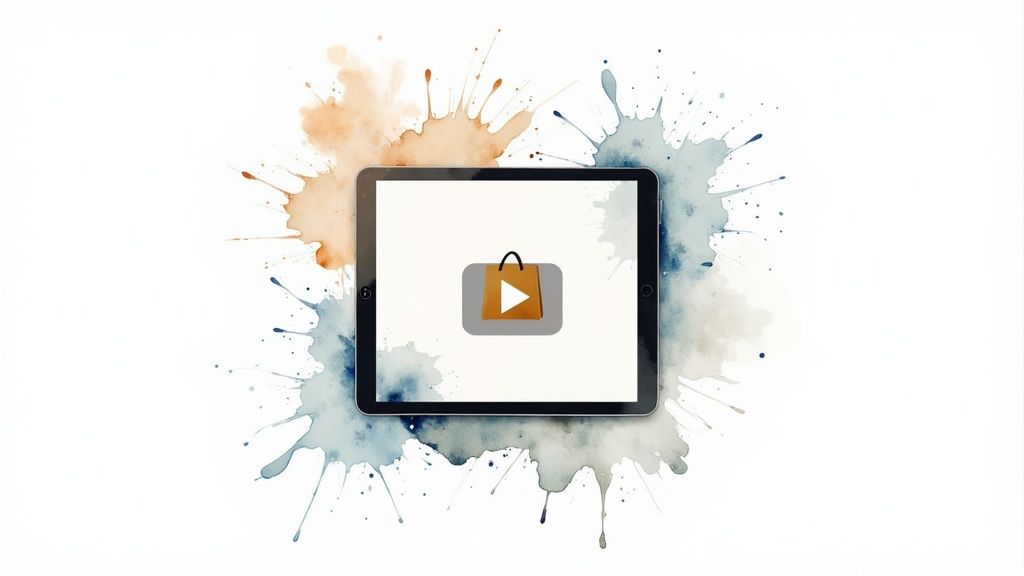Learn how to add video to Shopify quickly with proven tips to increase engagement and sales. Start transforming your store today!
In This Article
Subscribe to our newsletter
Why Videos Transform the Shopify Shopping Experience
Online shoppers today want more than just pictures; they're looking for immersive experiences. That's where video becomes crucial for Shopify stores. Videos change how customers interact with products, giving them a dynamic perspective that static images can't match. This shift in consumer behavior is fueling the demand for video content before purchases.
Building Trust and Reducing Uncertainty
Imagine buying a tent online. Would you prefer a few photos or a video demonstrating how to set it up? Videos bridge the gap between online and in-person shopping. They give a tangible sense of a product's size, texture, and function, building trust and lessening purchase anxiety. This transparency can lead to higher conversion rates. By showcasing a product's features and benefits in action, videos proactively answer customer questions, further building confidence.
Enhancing Engagement and Driving Conversions
Videos also keep customers on your site longer. This increased dwell time improves your store's SEO. Videos create an emotional connection that static images often miss. By seeing a product "in action" or hearing a testimonial, shoppers connect on a deeper level, making them more likely to buy. This creates a more satisfying shopping experience and boosts sales. Adding video to Shopify stores is increasingly important as video's popularity grows. By 2025, projections suggest about half of all online content consumed will be video, highlighting video marketing's potential impact on platforms like Shopify. Explore this topic further. Using video effectively boosts customer engagement and conversion rates. For instance, product videos on Shopify offer a dynamic way to showcase products, improving customer understanding and increasing sales.
Minimizing Returns and Boosting Customer Satisfaction
Videos significantly reduce returns by setting clear expectations. When customers understand a product before buying, they're less likely to be disappointed. This leads to higher customer satisfaction and fewer returns, benefiting both the customer and the business. Adding videos to your Shopify store isn't just a trend; it's a strategic move to improve the shopping experience, strengthen your brand, and boost sales. Learning how to add video to Shopify will become a valuable asset for any online business looking to succeed in today's competitive market.
Proven Methods to Add Videos to Your Product Pages
Adding videos to your Shopify product pages isn't just a nice extra anymore—it's a must-have for staying competitive. Videos bring your products to life, build customer trust, and boost sales. This guide explores different ways to seamlessly add videos to your Shopify store, from simple embeds to powerful app integrations.
Directly Through Shopify
Shopify lets you upload videos directly in the product page editor. This keeps everything within the Shopify platform, making it a streamlined approach.
- Access the product editor: In your Shopify admin, go to Products and select the product you want to edit.
- Add a video: In the Media section, click Add media and choose your video file. Shopify supports standard formats like .mp4 and .mov.
- Optimize for performance: Make sure your video file size is optimized for quick loading. Large files can slow down your page and hurt the user experience.
This direct upload method works well for basic product videos where you don't need lots of customization. However, it doesn't offer interactive features or advanced analytics.
Embedding From YouTube and Vimeo
Embedding videos from platforms like YouTube and Vimeo can help you reach a wider audience. It's usually straightforward, but requires attention to detail.
- Upload to YouTube/Vimeo: Upload your video to your preferred platform.
- Copy the embed code: Find and copy the video's embed code.
- Paste the code: In the Shopify product editor, switch to the HTML view and paste the embed code where you want the video to appear.
This method is great for social sharing and discoverability. However, external branding and potential ads could disrupt the shopping experience.
Leveraging Shopify Video Apps
Specialized Shopify video apps offer advanced features for interactive shopping. Think shoppable hotspots, 360-degree views, and customer-generated content galleries.
- Explore app options: Check the Shopify App Store for video apps that fit your needs and budget.
- Install and configure: Install your chosen app and adjust its settings.
- Integrate with your product pages: Follow the app’s instructions to add videos to your product pages.
To learn more about creating effective product videos, check out this guide: How to master product videos.
Shopify's growth highlights the importance of video marketing. In 2024, Shopify's revenue grew by 21% to $2 billion, and the platform hosted over 5.23 million websites globally. This shows a huge opportunity for integrating video content. Find more detailed statistics here.
The table below compares different ways to integrate video into your Shopify store. It highlights key differences and similarities to help you choose the best method for your business.
Video Integration Methods for ShopifyComparison of different methods to add videos to your Shopify store
| Method | Ease of Implementation | Features | Best For | Limitations |
|---|---|---|---|---|
| Direct Upload (Shopify) | Easy | Basic playback | Simple product videos | Lacks interactive elements and advanced analytics |
| YouTube/Vimeo Embed | Moderate | Social sharing, wider reach | Leveraging existing audiences | External branding, potential ads |
| Shopify Video Apps | Varies by app | Interactive elements, shoppable videos, advanced analytics | Enhanced shopping experiences | Cost, app complexity |

The infographic above shows the impact of video on product pages. Adding videos can increase conversion rates by 30%, boost average session duration by 45%, and reduce bounce rates by 20%. These are significant improvements to key performance indicators that directly impact sales and engagement. Choosing the right video integration method lets you create engaging shopping experiences that resonate with your customers. For any business, using video effectively is a major advantage in today's e-commerce world.
Creating Impact With Homepage and Collection Videos
Thinking about video just for product pages? Think bigger! Just like a physical store uses visuals throughout, your online Shopify store should leverage video across the entire customer journey. This section explores how strategically placed videos can elevate your homepage and collection pages, turning casual browsers into loyal customers.
Homepage Hero Videos: First Impressions Matter
Your homepage video is often a customer's first brand interaction. A compelling hero video, placed prominently at the top, creates an immediate emotional connection. It's not just about showing products; it's about telling your brand's story, values, and aesthetic. A well-crafted hero video can significantly reduce bounce rates, encouraging visitors to explore further. Imagine a clothing brand using a hero video to showcase the craftsmanship of their materials or the lifestyle associated with their line. This engaging introduction captures attention and sets the tone for the shopping experience.
Engaging Background Videos: Subtle Yet Powerful
Beyond hero videos, consider video backgrounds. These subtle moving visuals add dynamism without overwhelming the user. There are many ways to optimize your product pages to increase sales. For example, learning how to increase Shopify sales with a comprehensive playbook can be a great resource. However, ensure these background videos are optimized for performance. Use techniques like lazy loading to prevent slow load times. Lazy loading waits to load the video until it's needed, prioritizing above-the-fold content for a smooth initial page load.

Collection Page Videos: Guiding Purchase Decisions
Collection pages are key for organizing products and guiding customers toward specific categories. Adding videos here enriches browsing and helps shoppers discover relevant items. For example, an outdoor gear store could use videos on their "Hiking Gear" collection page to demonstrate backpack functionality or showcase the benefits of waterproof jackets. This targeted approach provides valuable context, helping customers visualize how products fit their activities.
Balancing Impact and Performance: Best Practices
Videos can impact site speed if not implemented correctly. Autoplay can grab attention but also annoy users. Use it sparingly and always provide pause/mute controls. Ensure your videos are mobile-optimized with compressed files and adaptive streaming for a seamless experience across devices. Finally, maintain a consistent content strategy across all video assets, aligning them with your brand messaging and aesthetic. By balancing visual impact with site performance, you create a Shopify experience that is both engaging and efficient, driving conversions and building brand loyalty.
Finding Your Perfect Shopify Video Solution
Choosing the right video solution for your Shopify store can be a real headache. The Shopify App Store is packed with options, making it tough to find the perfect fit. This section simplifies the process, offering practical advice based on extensive testing and real merchant experiences.
Matching Solutions to Your Business Needs
Every business has unique video needs. A small startup might prioritize a simple, affordable solution, while a larger company may need advanced features and scalability. Whether you're showcasing products, sharing customer testimonials, or building your brand story, the right solution aligns with your goals and budget. For example, a tech company selling complex equipment might use interactive 360-degree product views, while a fashion boutique might create lifestyle videos.

Exploring Dedicated Video Platforms and Integrations
Think beyond basic YouTube and Vimeo embeds. Dedicated video platforms like Videowise offer specialized e-commerce features like shoppable hotspots and customer-generated video galleries. They also provide in-depth analytics to track video performance and viewer behavior. However, these platforms often come with a higher price tag. Balancing features and cost is key for a strong video ROI.
Specialized Features for Enhanced Engagement
Many video apps offer advanced features to improve the shopping experience. Shoppable hotspots let viewers click products directly within a video, seamlessly adding them to their cart. 360-degree product views give customers an immersive look at products from all angles. Customer-generated video galleries build trust and authenticity by showcasing real user experiences. These interactive elements transform passive viewing into active engagement, driving conversions.
To help you choose the right app, we’ve compiled a comparison of the top video apps for Shopify:
To help you choose the best app, here's a comparison of leading video integration apps for your Shopify Store:
Top Video Apps for Shopify ComparisonDetailed comparison of the leading video integration apps for Shopify stores
| App Name | Core Features | Price Range | Ease of Use | Customer Support | Best For |
|---|---|---|---|---|---|
| Videowise | Shoppable videos, interactive elements, analytics | Varies based on plan | Generally user-friendly | Responsive support team | Businesses focused on interactive video experiences |
| Vimeo | High-quality video hosting, basic embedding options | Free and paid plans | Easy to use | Good support documentation | Simple video embedding needs |
| YouTube | Free video hosting, widespread reach | Free | Very easy to use | Large community support | Basic embedding and brand building |
This table summarizes the key features, pricing, and ideal use cases for each app, making it easier to choose the one that best fits your needs. Remember, the “best” app truly depends on your specific requirements and priorities.
Key Considerations for Choosing a Solution
When evaluating solutions, consider compatibility with your current Shopify theme. Some apps integrate more smoothly than others. Also, check the level of customer support. A responsive support team is essential for troubleshooting and implementing new features. Finally, look at real-world examples from other Shopify stores. Seeing how others use video can inspire your own strategy. By considering these factors, you can confidently choose a video solution that enhances the shopping experience. Learn more about efficiently creating high-quality video content for your Shopify store. Effective video integration helps you connect with your audience, build brand loyalty, and drive sales.
Balancing Video Quality With Loading Speed
High-quality videos can significantly enhance your Shopify store, showcasing products and captivating your audience. However, large video files can hinder your site's speed, leading to frustrated customers and lost sales. This section explores practical strategies for achieving the ideal balance between stunning visuals and fast loading times, ensuring your videos boost engagement without compromising performance. You might be interested in: How to master video optimization.
Optimizing Video Files for Peak Performance
Just like a finely tuned engine, your videos need optimization to run smoothly. File optimization is the key to maintaining visual appeal while minimizing file size.
Consider these essential techniques:
- Choose the Right Format: MP4 is generally the best format for Shopify, offering a good balance between quality and compression.
- Compress Your Videos: Tools like HandBrake can significantly reduce file size without drastically impacting quality. Think of it like packing a suitcase efficiently – you fit everything in without sacrificing the essentials.
- Adjust Resolution and Frame Rate: Lower resolutions (720p or 1080p) often suffice for online video and significantly reduce file size. Similarly, a lower frame rate (30fps) is suitable for most product videos.
Implementing Smart Loading Strategies
Optimizing files is just the first step. Implementing smart loading techniques ensures your videos load quickly and efficiently, providing a smooth user experience.
- Lazy Loading: This technique only loads videos when they're about to be viewed, prioritizing above-the-fold content. Imagine a long webpage – lazy loading only reveals content as you scroll down, preventing unnecessary initial load.
- Adaptive Streaming: This dynamic technique adjusts video quality based on the viewer's internet connection. If a customer has a slower connection, they'll receive a lower-resolution version, preventing buffering. Those with faster connections can enjoy high-definition playback.
Self-Hosting vs. Third-Party Platforms: Weighing the Pros and Cons
Deciding where to host your videos impacts loading speed. Self-hosting offers maximum control but requires managing bandwidth and server resources. Third-party platforms like YouTube and Vimeo handle hosting, but may introduce external branding and potential ads.
| Hosting Method | Pros | Cons |
|---|---|---|
| Self-Hosting | Full control, branding consistency | Requires server resources, bandwidth management |
| Third-Party | Easy implementation, wider reach | Potential ads, external branding |
Consider your business needs and technical capabilities when making this decision. A larger company with dedicated server resources might prefer self-hosting, while smaller businesses might find third-party platforms more convenient.
Mobile Optimization: Ensuring a Seamless Experience on All Devices
Optimizing videos for mobile devices is crucial. Large video files can quickly drain mobile data and lead to slow loading times. Implement mobile-specific compression and consider using shorter videos for mobile users.

Also, ensure your video player is responsive, adapting to different screen sizes for seamless playback. By following these tips, you can create a video strategy that enhances your Shopify store's performance and engages customers across all platforms.
Measuring Real Results From Your Video Investment
Adding videos to your Shopify store represents a significant investment of both time and resources. It's crucial to look beyond vanity metrics like simple view counts and delve into the real impact video has on your bottom line. This means understanding how video influences engagement, boosts conversion lift, and ultimately contributes to your ROI.
Tracking the Customer Journey: From View to Purchase
Understanding the customer journey is paramount. How do customers interact with your videos? And how do these interactions influence their purchasing decisions? Tools like Google Analytics, Shopify Reports, and specialized video analytics platforms help capture this valuable data. Track which videos are viewed most, how long customers watch, and if they proceed to product pages after viewing.
A/B Testing: Isolating Video’s Impact
A/B testing is one of the most effective methods for measuring video's impact. Create two versions of a product page: one with a video and one without. Compare their performance. This isolates the impact video has on conversion rates and average order value. Leading Shopify merchants use A/B testing to optimize video placement, content, and length. Remember that large video files can impact your website’s speed. Be sure to optimize images and videos for a smooth customer experience.
Analyzing Viewer Behavior: Refining Your Strategy
Analyzing viewer behavior offers critical insights. Tracking metrics like watch time, drop-off points, and engagement (likes, shares, comments) reveals what resonates with your audience. This data helps refine your video strategy. Is the content compelling? Is the video in the optimal location on the page? Are your calls to action effective? If viewers consistently drop off at a certain point, perhaps the pacing or content needs adjusting.
The effectiveness of video marketing on Shopify is tied to the platform's overall performance. The top 10% of Shopify stores achieve conversion rates above 4.7%, while the average click-through rate (CTR) is around 2.5%. Learn more about Shopify statistics. Video content contributes to these numbers by enriching the shopping experience. Product videos, for instance, enhance product visualization, leading to improved customer understanding and ultimately, higher conversion rates. By analyzing these metrics and understanding viewer behavior, you can optimize your videos to drive tangible business results. This approach goes beyond superficial metrics, focusing on real improvements to your store's performance and your bottom line. Continuous analysis and refinement ensure your videos remain a potent tool for attracting customers and boosting sales.
Crafting Videos That Actually Drive Purchases
Adding videos to your Shopify store is only half the battle. The real work begins when you craft videos that truly connect with your audience and encourage them to buy your products. This section explores creating videos that not only attract views but also turn those viewers into paying customers.
Understanding The Power of Different Video Types
Different video formats serve different purposes. A product demo video will differ significantly from a customer testimonial. Understanding these differences is crucial for tailoring your videos to your specific product and target audience.
Demonstrations and Explainers: These videos are excellent for showcasing your product's features and benefits. Show potential customers how your product solves a problem. For example, a demo could show a kitchen gadget easily slicing vegetables, or an explainer could highlight the benefits of a particular fabric.
Customer Testimonials: Featuring real customers discussing their positive experiences builds trust and social proof. Hearing a satisfied customer’s story resonates powerfully with potential buyers.
Lifestyle Content: These videos weave your products into a broader narrative, connecting them with your target audience's values and aspirations. A fitness brand might showcase their products during a workout, emphasizing achievement and dedication.
Production Approaches For Every Budget
Creating compelling video content doesn't necessitate a huge budget. Whether you use a smartphone or professional equipment, focus on clear messaging and high-quality visuals.
Smartphone Production: Modern smartphones offer impressive video recording capabilities. Use a tripod for stability, ensure good lighting, and consider external microphones for improved audio. Edit using user-friendly mobile apps like InShot or CapCut. This approach suits smaller businesses and startups.
Cost-Effective Professional Solutions: Freelance videographers and affordable editing software like DaVinci Resolve provide professional-level production without excessive expense. This option works well for businesses seeking a polished look.
Matching Video Investment To Product Value
Consider your product’s price, complexity, and common customer questions when determining your video investment. A high-value item like furniture likely warrants a more polished video than a low-priced phone case. For complex products, explainer videos can minimize customer confusion and boost sales. Proactively address customer questions to build trust.
Optimizing Video Length, Structure, and Messaging
Keep videos concise and engaging, ideally under two minutes. Structure your videos with a clear beginning, middle, and end. Begin by highlighting the problem your product solves. Then showcase features and benefits. Conclude with a strong call to action, directing viewers to your product page. Check out resources like How to master YouTube Shorts for further guidance.
Maintain consistent branding in your messaging and visuals to strengthen brand recognition. Use colors, fonts, and music that align with your overall brand aesthetic. Creating effective sales videos requires understanding your audience, crafting compelling narratives, and optimizing your content for conversions. These strategies can transform your videos into a powerful tool for growth.
Ready to improve your video creation? Aeon, an AI-powered video platform, enables publishers to effortlessly create engaging video content. Visit Aeon and discover how to streamline video production while retaining editorial control.


.jpg)